- Home
- Top Sarawak Attractions
- Kuching City Highlights Walk
Kuching City Highlights Walk
Sarawak's capital city, Kuching is an interesting place. It's a fast expanding city but the good news is that most of the main tourist sights are concentrated in a reasonably compact area which can be covered on foot.
In this Kuching City Highlights Walk, I have compiled a map showing all the main heritage buildings and places of interest. Pan and zoom on the map for a close up.
There are 46 places marked on the map and I visited them all in October 2013 in one full and tiring day.
If you follow the places of interest 1 - 46 in sequence you can see them all without too much back-tracking. Alternatively you could split the itinerary into 2 or more days.
Sarawak Heritage Society produced its own Kuching Heritage Trail (The Brooke Legacy) some time ago but when I asked for a copy of the map at the Tourist Information Office they told me that it was no longer available.
Never mind, I have incorporated all of their places of interest in my Kuching City Highlights Walk and I have added another 20 or so extras.
The Kuching City Highlights Walk starts at Bulatan Sri Aman, facing the HSBC building.
 |
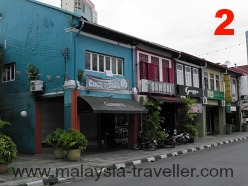 |
|
1. Cat Statue. Kuching means cat and the city boasts a considerable number of cat statues. This one is known as the Great Cat of Kuching. |
2. A Chinese archway behind welcomes visitors to Jalan Padungan, one of the main shopping arteries of the city.There are a lot of coffee shops, small restaurants and a variety of stores on this street. The five foot walkway (kaki lima) is noticeably wider here than in Peninsula Malaysia - more like a ten foot walkway. |
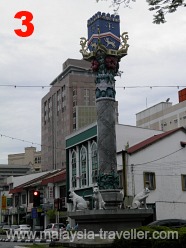 |
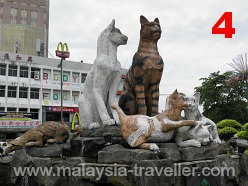 |
|
3 & 4. There are a couple more examples of cat statues here as Jalan Padungan ends and gives way to an area of modern shopping malls and high-rise hotels. | |
 |
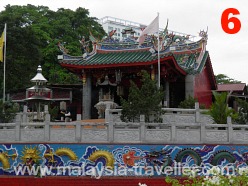 |
|
5. The round Khatulistawa Restaurant building is an interesting design and enjoys a great location on the bank of the Sarawak River. However I cannot vouch for the food or service. |
6. You can walk along the pleasant embankment here, past the Hilton as far as the Tua Pek Kong Temple. This is possibly the oldest Chinese temple in Kuching dating from before 1839 and is believed to have been built by migrants from Kalimantan. The dragon frieze was added in the 1980's. |
 |
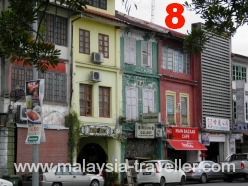 |
|
7. Across the street is the Chinese History Museum. This small building started life in 1912 as a court where civil disputes among the Chinese community were heard and settled. Charles Vyner Brooke, the Rajah at the time, wished his Chinese subjects to manage their own affairs. The building later served as the Chinese Chamber of Commerce before being converted to a museum in 1993. It screens a video presentation on how the Chinese migrated to Sarawak. There are also displays explaining the different Chinese communities, biographies of some famous Sarawakian Chinese, and exhibits from daily life in bygone years. |
8. The street fronting the river here is Jalan Main Bazaar. There are many tourist handicraft and antique shops and budget/boutique hotels on this stretch. |
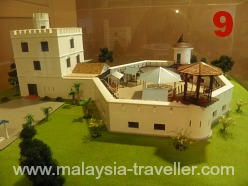 |
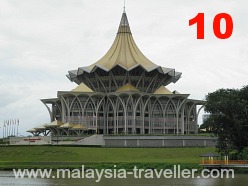 |
|
9. On the opposite bank of the river you can glimpse Fort Margherita (covered in scaffolding and hoarding). It was built in 1879 and named after the wife of the then Rajah. I visited it many years ago when it was open as a Police Museum but it has been closed for some time for renovations. Until it reopens there is no need to cross the river here. |
10. You cannot help noticing the Sarawak State Assembly building with its striking modern design, also across the river from here. It was completed in 2009. |
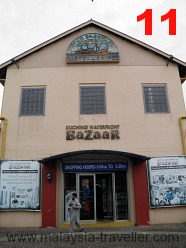 |
 |
|
11. Continuing along the river bank you will reach the Old Sarawak Steamship building. Built in the 1930's as a warehouse, it now contains souvenir shops and food outlets. |
12. Once an area of godowns and wharves, the Kuching Waterfront has been beautified and landscaped with sitting out areas and viewing platforms. |
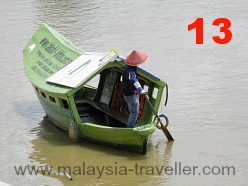 |
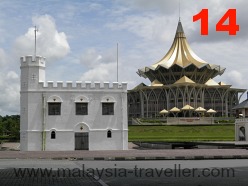 |
|
13. At various points along the riverbank you can catch little ferry boats, called tambang, which hold up to ten passengers and cost 50 sen for a trip across to the other bank of the river. I took one across to Kampung Lintang (or KL as one guy joked) just for the experience. I was impressed with the boatman's skills at negotiating the fast moving current. There are reports that a pedestrian bridge is to be built across the river which might put the boatmen out of business. I think most locals will still take the tambun to avoid walking. |
14. The Square Tower (1879) was completed at the same time as Fort Margharita and together they guarded both banks of the river. Over its lifetime, this building has served as a fort, a prison and a dance hall. Now it appears to be unused. |
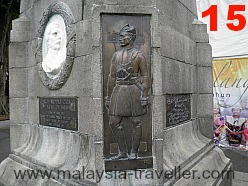 |
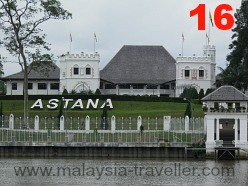 |
|
15. The Brooke Memorial is a granite cenotaph erected in 1924 to commemorate the second Rajah, Charles Brooke. It bears 4 bronze plaques depicting the main communities of Sarawak; the Iban, Chinese, Malay and Kayan. |
16. The Astana, on the opposite bank of the river, was built in 1870 as the residence of the Rajah. Now it is the official residence of the State Governor and it is not open to the public. |
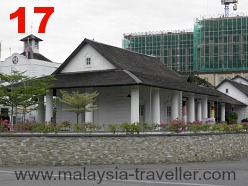 |
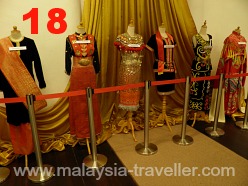 |
|
17. The Old Kuching Courthouse is a fine example of Brooke-era architecture with wide and airy verandahs supported by Roman style columns. It was commenced in 1868 and over the following decades adjoining government department offices were added in the same complex as the requirements of the government grew. |
18. One of these buildings now houses a Women's Museum while another is occupied by the Sarawak Tourism Complex. |
 |
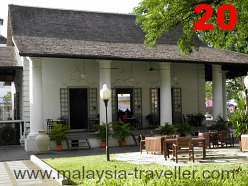 |
|
19. The South Wing of the Court House complex was used as the District Office and comprised Customs and Excise, Births and Deaths registration, Mines, Forestry, Lands Department and others. |
20. During Brooke's time, the Native Court oversaw all matters pertaining to native laws and traditions, especially those of the Malays. This block is now a restaurant. |
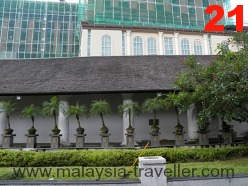 |
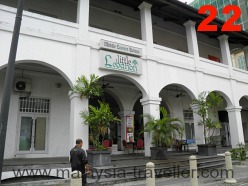 |
|
21. The Old Government Treasury & Audit Department was completed in 1927. It was later used by Bank Negara Malaysia. A reinforced concrete vault was installed in the basement at this time. |
22. The 'Japanese Building' was constructed during the Japanese occupation in World War Two using POW's as labourers. It is now used by a Lebanese restaurant. |
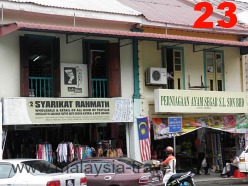 |
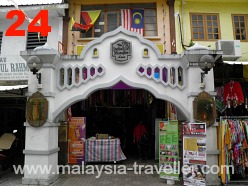 |
|
23. Jalan Gambir (Gambier Street) is named after the gambier plant whose leaves were/are used for chewing with betel and for use with tanning leather. It was one of Sarawak's chief export products in the late 19th century. Today this street has many dried seafood and spice shops. |
24. From here you can cut down a narrow alley known as Lorong Sempit or Indian Mosque Lane which passes the Indian Mosque before emerging on India Street. |
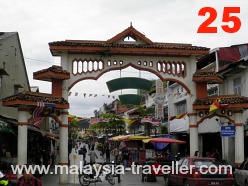 |
 |
|
25. India Street was once known as Kling Street but the name was changed in 1928 to reflect the large number of Indian owned shops here. Nowadays it is a pedestrianised street, which makes a nice change, but does not seem particularly Indian. |
26. Near the Market area you can find the 'Open Air' Food Court (actually covered) and the site of the old Fire Station of which only the Lookout Tower still remains. |
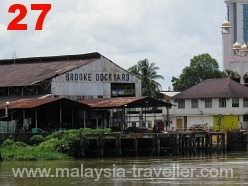 |
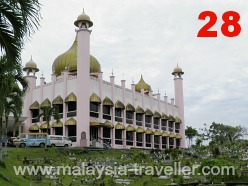 |
|
27. The Brooke Dockyard was opened in 1912, the same year that the Titanic sank. It is still operating and a small dry dock facility lies alongside the rusty tin godown. The firm has a large new facility in another location for its marine engineering business. |
28. Old State Mosque. There has been a mosque on this site since 1847 but the current building dates from 1968. It served as State Mosque until a new one was built on the northern side of the river in 1990. |
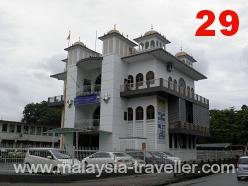 |
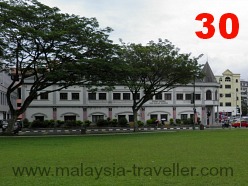 |
|
29. The nearby Gurdwara Sahib Sikh Temple was opened in 1982. Sikhs were introduced into Kuching during the colonial era when most served as police, watchmen or prison wardens. |
30. On Jalan Barrack facing the Padang is the old Government Printing Press, completed in 1908. Today this building houses the Kuching District Council. |
 |
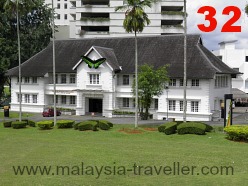 |
|
31. On the adjacent corner is the blue and white police station with the date 1931 inscribed above the door. |
32. From here you can cut across the Padang and admire the magnificent buttress roots of a giant Kapok tree growing here. You will soon arrive at the museum complex (all free admission), starting with the Natural History Museum. |
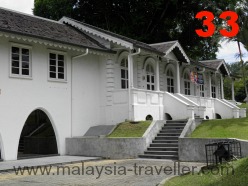 |
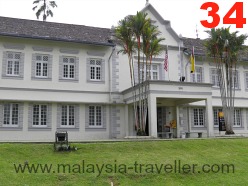 |
|
33. Next door is the Art Museum. Apart from some examples of indigenous tribal art the space was mostly filled with modern displays. |
34. Next stop on our Kuching City Highlights Walk is the Sarawak Museum which is in two buildings. The old wing is a very attractive building dating from 1891 which was said to have been modelled on the design of a town hall in Normandy, France. It's an old style museum with glass display cabinets filled with stuffed animals, examples of handicrafts and so on. |
 |
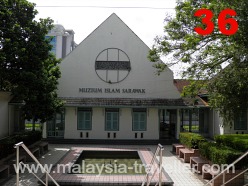 |
|
35. The newer wing takes you on a journey of Sarawak through the ages. All these museums are open from 9am - 4.45pm on weekdays and from 10am to 4pm on weekends and public holidays. |
36. The Islamic Museum nearby is definitely worth visiting (also free admission). It comprises seven galleries, each with a different theme such as architecture, science, weaponry or decorative arts. |
 |
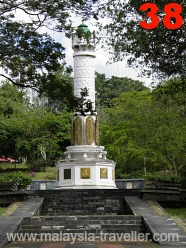 |
|
37. There is a small aquarium behind the Sarawak Museum old wing. It is housed in a Victorian cast iron gazebo and contains a few dozen tanks with a selection of tropical fish. Admission is free. |
38. You could take a short rest in the 6 acre gardens next to the aquarium where you can find a decorated column called the Heroes Monument dedicated to some local warriors. Unfortunately there is no explanation of who they were. |
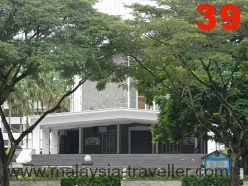 |
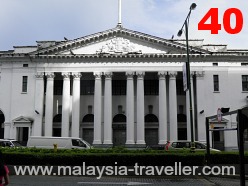 |
|
39. Retracing your steps somewhat you return to the Padang, passing St. Thomas's Cathedral. There was a wooden church on this site from 1849 until replaced by the current Anglican cathedral in 1954. The cathedral is part of a large compound which includes schools, a magnificent colonial residence called Bishop's House and other historic buildings. |
40. Next stop on the Kuching City Highlights Walk is the General Post Office, a very grand structure with a neo-classical facade that would look at home in London or Manchester. The building is still in use as a post office. |
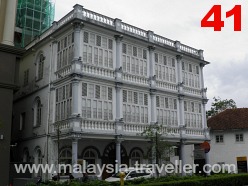 |
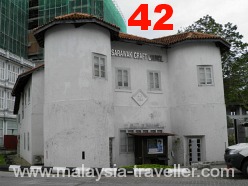 |
|
41. Across the street is the Pavilion (1909) which was originally the Medical Headquarters and people would use its flat roof top as a vantage point to enjoy the sunset. It is now the Sarawak Textile Museum and has the same opening hours as the other museums. Admission is free. |
42. Next door is the Round Tower which was completed in 1886. It was probably designed for defensive purposes. Now it houses the Sarawak Craft Council. |
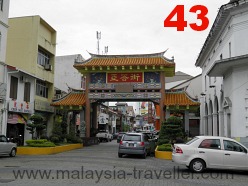 |
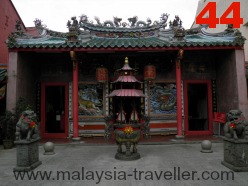 |
|
43. Harmony Arch is a recently built traditional Chinese gateway marking the entrance to Carpenter Street. |
44. Hiang Thian Siang Ti (Deity of the North) Temple was built by Teochow immigrants in 1863. Following a fire it was rebuilt in 1889 and extensively renovated in 1968. |
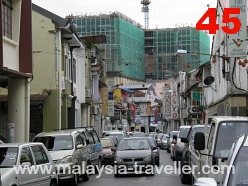 |
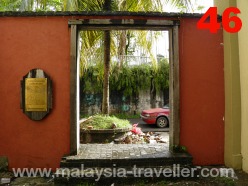 |
|
45. Carpenter Street was known for carpentry workshops as well as opium dens, gambling joints and brothels which used to operate here until they were eradicated by the British. There are still a number of carpentry and furniture shops along this street. |
46. Bishopgate Road is a small alley leading to a doorway which, during the 19th century, used to give access from the Anglican Mission complex to the waterfront. The stout ironwood doors would have protected the church folk from the shady goings-on in notorious Carpenter Street. |
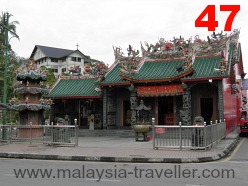 |
47. Kueh Seng Onn Temple is the final stop on this Kuching City Highlights Walk. This temple was built by the Hokkien community in 1895, although the current building is a modern replacement (2005). |
Interested in more walks like this? See my Malaysia City Trails page.
- Home
- Top Sarawak Attractions
- Kuching City Highlights Walk
Share this page:




Comments
Have your say about what you just read! Leave me a comment in the box below.